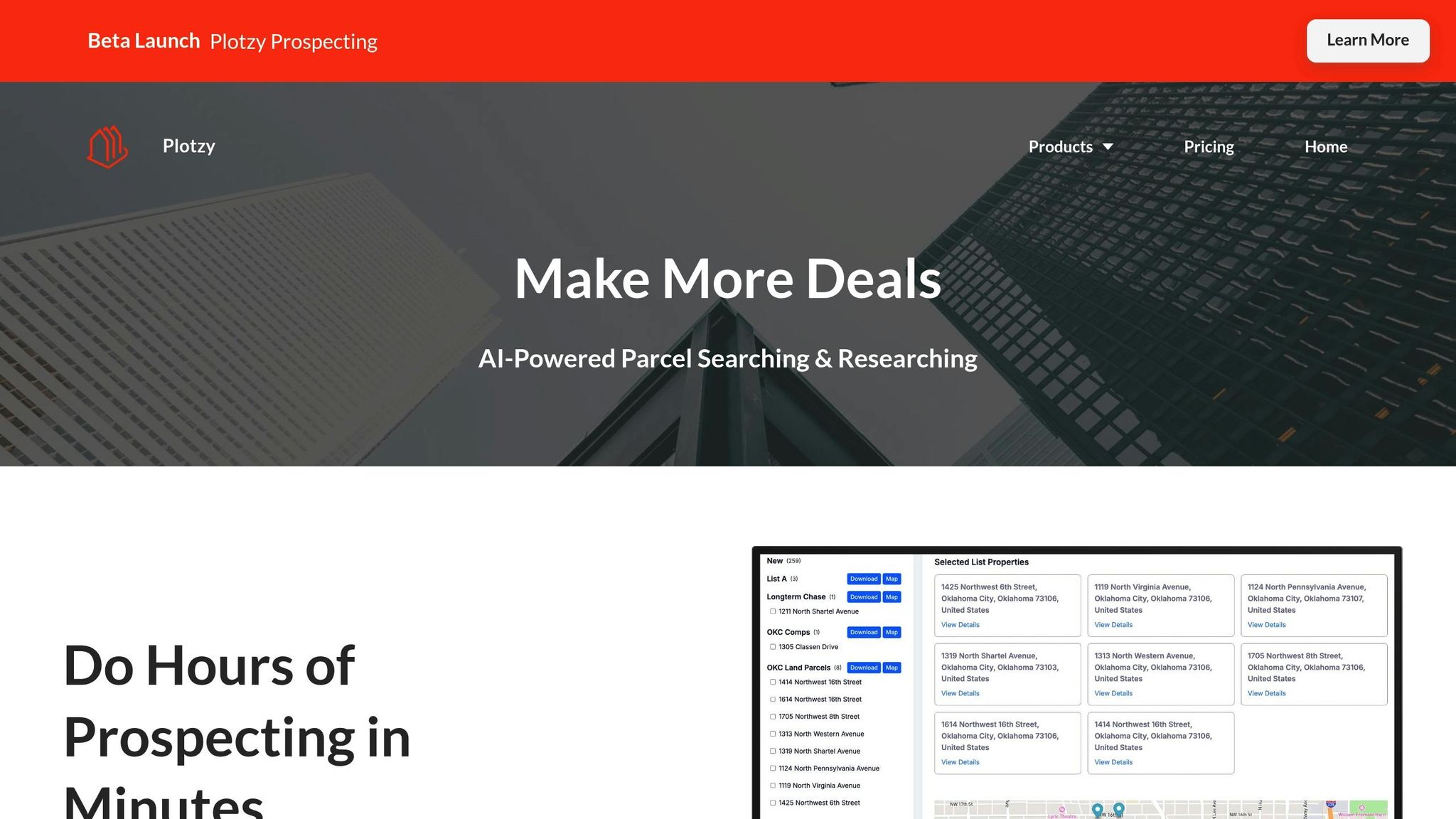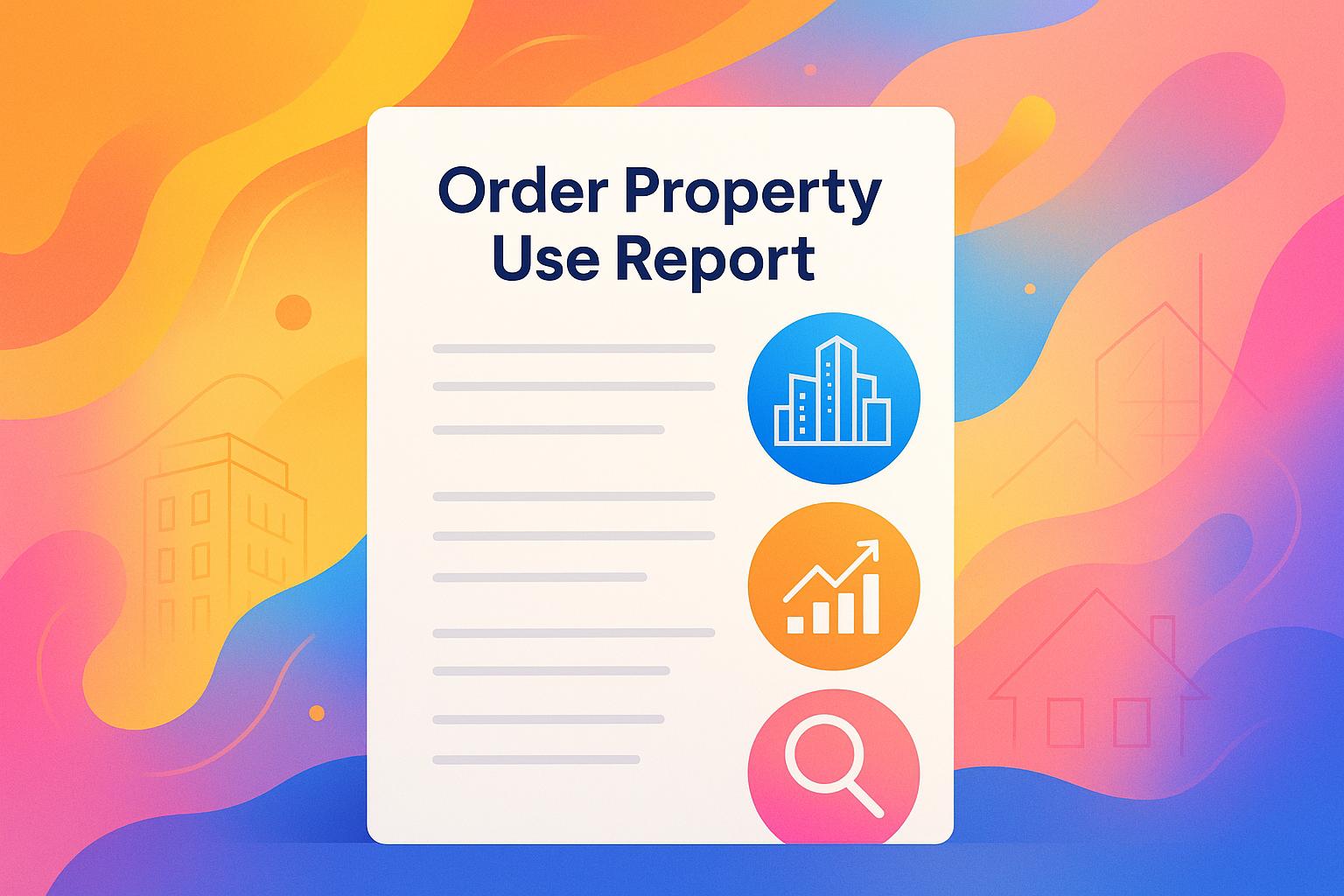Zoning data defines how land can be used and developed, and when paired with AI, it transforms real estate forecasting. Here's what you need to know:
- Zoning Data Basics: Outlines land use, building types, density limits, and regulations.
- AI's Role: AI uses zoning data to predict property values, identify investment opportunities, and streamline compliance.
- Key Benefits:
- Accurate property valuations based on zoning rules.
- Detection of underutilized properties for redevelopment.
- Faster zoning compliance checks.
- Insights into future rezoning trends.
- Challenges:
- Inconsistent zoning data across jurisdictions.
- High costs of AI adoption.
- Algorithmic bias risks.
- Future Trends:
- Digital zoning maps for streamlined analysis.
- AI tools like Plotzy simplifying property research.
- Increased use of predictive zoning insights.
AI-powered zoning analysis is reshaping real estate, making property research faster, more precise, and data-driven. However, challenges like data inconsistencies and high costs need to be addressed for broader adoption.
AI for Due Diligence! How to Review Zoning Rules, Covenants & Restrictions
How Zoning Data Affects AI Price Forecasting
Zoning data plays a key role in how AI systems predict property values. By analyzing details like permitted uses, density limits, and development potential, AI models can provide accurate forecasts for price trends.
How Zoning Data Affects Property Valuation
Permitted use classifications are a cornerstone of AI-driven property valuation. Properties zoned for commercial use often carry higher market values compared to residential ones, primarily due to their income-generating potential. AI systems use this data to pinpoint value differences across similar properties based on their zoning designations.
Density restrictions and Floor Area Ratio (FAR) significantly influence how AI calculates a property's development potential. For example, in New York State, the residential FAR cap of 12 limits the addition of new residential units. AI models incorporate these parameters into their pricing predictions, factoring in the constraints they impose.
"FAR might look like a static number, but the way you access additional floor area in Manhattan is anything but simple. Every merger, bonus, or waiver affects design, timing, and public commitments. It's why zoning strategy has to be built into the financial model from day one." - Alan Hall, zoning expert with LightBox PZR
Mixed-use zoning flexibility also drives higher valuations. Properties with mixed-use zoning offer more development opportunities compared to single-use zoning, and AI models weigh this flexibility heavily when predicting long-term appreciation.
Air rights transfers introduce another layer of complexity that AI systems are now starting to interpret. By shifting development potential across properties, air rights can significantly impact value in ways traditional appraisals often overlook.
"Air rights are one of the most powerful and misunderstood tools in New York City development. They allow value to shift across lots in a way that few other levers can - but unlocking that value takes deep technical knowledge and close collaboration with city agencies." - Michael Fraser, SVP of Risk and Due Diligence with LightBox
These insights help AI models uncover hidden opportunities, particularly in underutilized properties.
Finding Underutilized Properties Using AI
AI excels at identifying properties that aren't fully leveraging their zoning potential. These "zoning arbitrage" opportunities can highlight lucrative investment prospects.
Automated underutilization detection is one way AI identifies these opportunities. By comparing a property's current use to its maximum allowable development under zoning rules, AI can flag redevelopment possibilities. For instance, a single-story building on land zoned for multi-story, mixed-use development could signal untapped potential.
The demand for this type of analysis is growing. Zoning report volumes rose by 20% in 2024 and another 12% in the first two months of 2025. Multifamily properties made up 29% of total zoning reports in 2024, while self-storage properties increased their share by 3.2%, reaching 8.2% of the total.
"The most powerful combination is having digitized data and AI models to detect zoning arbitrage signals across all cities of interest." - Olivia Ramos, Founder and CEO of Deepblocks
Predictive rezoning analysis is another area where AI shines. By studying historical zoning changes and development trends, AI can anticipate where future zoning modifications might occur, giving investors a strategic edge.
Adaptive reuse opportunities are gaining traction as market needs evolve. AI tools can identify properties suited for conversion, such as turning an office building into residential or mixed-use spaces.
Case Example: AI and Zoning Data for Site Selection
The integration of AI and zoning data has transformed site selection strategies. For example, One Ontario utilized the LandLogic platform to streamline its site selection process in Toronto. The company used AI-powered zoning analysis to identify underutilized parcels zoned for multiplex developments that met CMHC's five-unit rental criteria.
This process involved scanning thousands of properties to find those with the right zoning, lot sizes, and financing compatibility. By automating these tasks, the company cut weeks of manual research, sped up project timelines, and minimized regulatory risks. The scalability of this approach allowed entire neighborhoods to be analyzed at once, enabling developers to quickly pinpoint the most promising opportunities.
AI tools like Plotzy further simplify property searches by filtering results based on permitted uses, making the entire process more efficient.
Using Zoning Data with Other Real Estate Information
Zoning data is a powerful tool for predicting real estate trends, but its real strength emerges when combined with other datasets. By layering information like demographics, economic indicators, and infrastructure data, AI models can deliver sharper predictions and reveal investment opportunities that might otherwise go unnoticed.
Building Better AI Models with Multiple Data Sources
Combining zoning data with other datasets significantly enhances property evaluations. For example, pairing zoning information - such as mixed-use permissions - with demographic insights like population growth and rising income levels allows AI to pinpoint areas likely to see property value increases.
Economic indicators add another layer of precision, while infrastructure data, integrated through Geographic Information System (GIS) technologies, helps optimize land use decisions. GIS tools can overlay demographic trends, zoning regulations, and infrastructure data to refine land selection strategies. On top of that, AI systems can personalize property recommendations by analyzing buyer preferences, budgets, and behaviors, delivering tailored solutions for investors and homebuyers alike.
By processing vast amounts of market data - ranging from local development plans to economic trends - AI systems can identify lucrative opportunities and provide a competitive edge in the real estate market.
Problems with Standardizing Zoning Data Across Jurisdictions
One of the biggest hurdles in using zoning data lies in its inconsistency across jurisdictions. For instance, a zoning classification like R1 (single-family residential) in Los Angeles might allow short-term rentals, while the same classification in Portland might prohibit them. These differences create challenges for AI systems trying to analyze data across multiple markets.
Other complications include varying data quality, inconsistent coordinate systems, and differing address formats, all of which make it difficult to integrate zoning data seamlessly. In California alone, over 250,000 parcels require updates annually, highlighting the dynamic and fragmented nature of land records.
"Since parcels are fundamental to all of our projects, we always want to have the most current and accurate data to start with." – representative, LSA Associates, Inc.
Additionally, data-sharing restrictions and the lack of uniform standards further complicate efforts to create a unified system for AI analysis. According to the FGDC Subcommittee for Cadastral Data, achieving comprehensive digital parcel coverage across the U.S. would require $294.6 million in one-time costs and $84.7 million annually for updates.
Addressing these challenges will require systematic solutions, such as assigning clear stewardship responsibilities across jurisdictions and adopting consistent data management practices. Centralized digital solutions could play a key role in overcoming these barriers.
"The confidence of knowing we always have the most up-to-date data is huge." – representative, LSA Associates, Inc.
How Digital Zoning Maps Help AI Analysis
Digital zoning maps offer a practical solution to standardization challenges, centralizing zoning data in one place and eliminating the need to consult multiple municipal websites. This streamlining makes analysis more efficient and accessible.
For example, the National Zoning Atlas, launched in 2020 at Cornell University, has become a robust resource for making zoning data actionable. Cities like Austin and Prince George County in Maryland have partnered with GIS companies to provide interactive tools that allow users to compare current and proposed zoning maps side by side. These visual tools simplify decision-making and improve transparency.
Digital zoning maps also enable predictive zoning analysis by incorporating upcoming changes. Emerging tools now allow cities to share future zoning modifications, which are crucial for long-term planning. Instead of relying on manual processes, GIS integration and AI algorithms can objectively assess multiple data sources at once, delivering faster and more accurate insights.
Public access to digital zoning maps enhances market transparency, helping residents and investors understand zoning regulations and potential developments. This accessibility levels the playing field, making comprehensive zoning data available to everyone.
The growing importance of these tools is reflected in the booming PropTech market, which was valued at $33.57 billion in 2023 and is projected to reach $89.93 billion by 2032. Digital zoning maps and AI-driven analysis are becoming indispensable for real estate investment and development.
sbb-itb-11d231f
AI Tools and Methods for Zoning Data Analysis
The commercial real estate (CRE) industry is increasingly embracing AI to tackle zoning data analysis. With 28% of commercial real estate firms already using AI and machine learning for decision-making and 33% planning to invest in these technologies in the next two to three years, automated zoning analysis is becoming a key focus.
Machine Learning Methods for Zoning Analysis
Machine learning has proven to be a game-changer for zoning data analysis, offering more precise tools for real estate predictions. For example, XGBoost, a gradient boosting algorithm, has demonstrated exceptional performance when working with complex zoning datasets. A study analyzing data from 1978 to mid-2024 revealed that XGBoost reduced forecasting errors by 68% compared to simple regression models and by 26% compared to multivariate regression models when predicting real estate returns.
Different machine learning models handle zoning data in unique ways:
| Model Type | Benefits | Limitations |
|---|---|---|
| Single regression using only REIT returns | Simple and uses observed real estate market data to predict private returns. | Limited in scope, as it includes non-real estate factors from stock markets and ownership structures. |
| Multivariate regression | Offers insight into key variables and their impact on outcomes. | Assumes linear relationships and requires pre-identified factors. |
| Machine learning | Captures nonlinear relationships and handles high-dimensional variables effectively. | Often lacks transparency, making it harder to interpret results ("black box" issue). |
Machine learning excels in tasks like classification algorithms, which categorize properties by zoning designations, and regression models, which predict property values based on zoning characteristics. Additionally, pattern recognition techniques identify trends in zoning changes and their influence on property values. This is particularly useful in understanding how factors like proximity to transit hubs, mixed-use zoning, and density allowances interact.
Combining human expertise with machine learning often delivers the best results. Judah Axelrod from Data@Urban highlights this synergy:
"We believe that automation can make data collection efforts easier in many areas, including web scraping to collect zoning documents, OCR to quickly and effectively extract text from documents, text analysis to flag relevant portions and save time for human reviewers, and data validation rules to speed up the current manual checks."
These advancements underline the growing importance of transparent AI in real estate, especially when high-stakes decisions depend on zoning-based predictions.
Why Clear AI Explanations Matter in Real Estate Predictions
Despite their accuracy, machine learning models often lack transparency, which can be a significant drawback in real estate. Since these tools influence multi-million-dollar investments and community planning, stakeholders need clear, understandable insights into how predictions are made. For instance, if an AI model forecasts a 15% rise in property value after rezoning, investors want to know if this is due to increased density allowances, mixed-use permissions, or proximity to transit-oriented developments.
The industry is shifting toward interpretable machine learning models, which aim to balance accuracy with clarity. These models highlight the specific zoning factors driving predictions, enabling real estate professionals to make informed decisions with greater confidence.
In 2024, Langan Engineering and Environmental Services showcased this balance by using generative AI to generate multiple project ideas for a riverfront site within minutes. The system proposed options for office spaces, retail centers, data hubs, warehouses, and apartments, each with distinct configurations. This allowed investors to quickly evaluate the feasibility and profitability of various scenarios.
As Eric Wittner, Senior Project Manager, puts it:
"AI does not replace the human factor... It's there to augment how you work, not to replace you."
How Plotzy Makes Zoning-Based Property Research Easier

Plotzy's AI-powered platform simplifies zoning data analysis and property research, saving users from the tedious task of manually reviewing zoning maps and regulations.
With its parcel search feature, users can locate properties based on zoning classifications and specific criteria, such as mixed-use zoning for development projects. The platform also provides instant zoning insights and access to owner contact information, making it easier to pursue off-market deals.
Plotzy's property reports combine zoning data with other key property details, offering a comprehensive view for site selection and valuation decisions. By processing large volumes of municipal data, the platform transforms complex zoning codes into actionable insights, empowering commercial real estate professionals to make quicker, more informed decisions.
As 36% of commercial real estate firms invest in machine learning and data science to stay competitive, tools like Plotzy are leading the shift from manual, time-consuming research to AI-driven analysis. These advancements are reshaping how zoning data influences real estate forecasts and investment strategies.
Benefits and Drawbacks of Using Zoning Data in AI Predictions
Using zoning data in AI-powered real estate forecasting offers both opportunities and challenges. With the AI real estate market expected to hit $1.34 trillion by 2029, understanding these trade-offs is essential for professionals navigating technology investments in commercial real estate.
Benefits of Zoning Data in AI Models
Incorporating zoning data into AI systems can significantly enhance property valuation accuracy and consistency. This approach has been shown to cut operating costs by 49% and increase revenue by 63%, thanks to the ability to process vast datasets with objectivity.
AI also excels at spotting underutilized properties by identifying those not fully leveraging their zoning potential. Additionally, it can anticipate zoning changes by analyzing historical trends and development patterns, giving investors a strategic edge in predicting market shifts. Beyond that, AI simplifies compliance with zoning regulations, reducing the time needed for approvals.
Christopher A. Watson, Director of Planning and Development Services at Murphy Schiller & Wilkes LLP, highlights the synergy between AI and human expertise:
"AI enhances planning by modeling future spaces and analyzing costs with speed and precision. It brings predictability to real estate development while preserving the vital role of human insight. As a tool, AI complements planners, enabling them to shape spaces that truly serve their communities."
Challenges of Adding Zoning Data to AI Systems
Despite these advantages, integrating zoning data into AI models comes with its own set of hurdles. Inaccurate or incomplete data can undermine AI performance, and zoning information often varies widely between jurisdictions. Municipal records are frequently inconsistent, outdated, or incomplete, complicating data integration.
System incompatibility is another issue, as different platforms may not work seamlessly together. Additionally, many real estate firms lack the technical expertise to build and maintain AI systems, leading to reliance on external vendors and higher implementation costs. Algorithmic bias also presents a risk, as biased data can lead to discriminatory outcomes. On top of these challenges, legal and regulatory frameworks surrounding AI in real estate remain in flux, adding layers of complexity. Resistance to AI adoption, driven by concerns over job security or a lack of understanding, further complicates implementation.
Comparison of Benefits and Drawbacks
Here’s a side-by-side look at the advantages and challenges of using zoning data in AI:
| Benefits | Drawbacks |
|---|---|
| Precise property valuations | Inconsistent data across jurisdictions |
| Scalable analysis of property portfolios | High initial technology adoption costs |
| Early detection of investment opportunities | Regulatory uncertainty and compliance risks |
| Simplified compliance with regulations | Limited technical expertise in the industry |
| Predictive zoning change insights | Algorithmic bias risks |
| Cost savings and revenue growth | Resistance to change from staff |
| Faster handling of zoning complexities | System compatibility issues |
When implemented effectively, combining zoning data with AI could unlock $110–$180 billion in market value. However, achieving this potential requires meticulous planning and risk mitigation.
Real estate firms should prioritize thorough risk assessments before rolling out AI tools. Establishing robust data collection methods and conducting regular quality checks can help maintain data integrity. A balanced approach - merging AI-driven insights with human expertise - offers the best results, as local market knowledge remains irreplaceable.
To overcome challenges, companies can partner with specialized AI/ML service providers for smoother integration and adopt cloud-based AI solutions to ensure scalability. Transparency is also crucial - explaining how AI works and its benefits can help build trust among users and stakeholders.
Conclusion: The Future of Zoning Data in AI Predictions
The combination of zoning data and AI technology is changing the game for commercial real estate professionals. It’s redefining how they conduct property research, evaluate investments, and make critical decisions. While challenges exist, this pairing is pushing traditional real estate analysis into new territory. Let’s break down the key insights and what lies ahead for the industry.
Key Takeaways
Zoning data plays a pivotal role in powering AI-driven real estate forecasts. It enhances property valuation accuracy and uncovers hidden investment opportunities. For example, AI integration can boost net cash flow by over 10%, and according to the McKinsey Global Institute, AI could create between $110 billion and $180 billion in value for real estate professionals.
The most impactful strategies combine AI’s precision with human expertise - leveraging technology while staying grounded in local market knowledge and community dynamics.
Take Plotzy, for instance. Their approach showcases how zoning data and AI can streamline property research. By filtering parcels based on zoning rules, providing owner details, and generating comprehensive reports, Plotzy turns days of manual research into seconds of automated insights. This type of efficiency not only saves time but also sharpens decision-making.
The winning formula? Embrace AI tools while maintaining a deep understanding of market trends and local nuances to seize new opportunities.
Looking Ahead: How AI Will Change Real Estate
The future of real estate looks even more promising as AI continues to reshape industry norms. Projections show the AI in real estate market will grow from $222.65 billion in 2024 to $303.06 billion in 2025, with a compound annual growth rate of 36.1%. This rapid growth signals broader adoption and increasingly advanced applications.
We’re likely to see zoning laws evolve to support mixed-use developments that blend residential, commercial, and recreational spaces efficiently. Green zoning initiatives may also take center stage, requiring sustainable building practices and offering incentives for developers who adopt eco-friendly technologies. Additionally, zoning policies could prioritize developments around transit hubs, promoting compact, walkable communities.
Even the approval process for developments is set to become more efficient. Digital platforms will enable real-time updates on application statuses, while AI-driven systems will automate plan reviews and compliance checks, significantly cutting down lead times.
By 2025, integrating AI tools and data into daily operations won’t just be an advantage - it’ll be a necessity. Real estate teams will need to upgrade their tech infrastructure and invest in training to keep pace with AI advancements.
As these changes unfold, professionals who blend AI capabilities with their expertise will be best positioned to thrive in this evolving landscape. The future of real estate is here, and it’s powered by data, technology, and innovation.
FAQs
How does AI handle inconsistencies in zoning data across different regions?
AI addresses the issue of inconsistent zoning data by leveraging advanced techniques to clean, organize, and standardize the information. These methods help detect patterns, fill in missing details, and fix errors, resulting in more reliable and usable zoning data.
Beyond just cleaning up the data, AI models take it a step further by analyzing elements like historical zoning changes, satellite images, and traffic patterns. This allows AI to forecast potential zoning updates, giving real estate professionals a clearer picture of future developments. By merging data refinement with predictive analysis, AI delivers practical insights that enhance property research and improve land use planning.
How do digital zoning maps improve AI predictions for real estate investments?
Digital zoning maps are a game-changer for AI predictions in real estate. They provide detailed land use data, which helps AI models recognize zoning patterns, predict urban growth trends, and pinpoint gaps in zoning regulations.
When zoning data is factored in, AI tools can deliver sharper insights into property values, ideal land use, and potential growth areas. This equips investors and developers with the knowledge they need to make smarter, data-backed decisions when exploring real estate opportunities.
How does AI zoning analysis uncover redevelopment opportunities in underused properties?
AI-driven zoning analysis is transforming how we identify underutilized properties. By quickly evaluating zoning regulations and development potential, these tools can analyze critical factors like maximum building heights, floor area ratios, and allowable property uses. This makes it easier to spot parcels that aren't fully taking advantage of their zoning potential.
On top of that, AI can sift through municipal data to highlight sites with untapped possibilities. For instance, it can flag properties suitable for higher-density construction or mixed-use developments. This gives developers and investors a clear path to uncover promising redevelopment opportunities and find hidden value in underused real estate.


